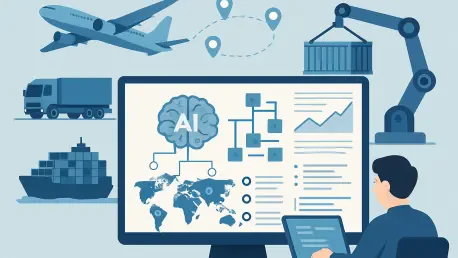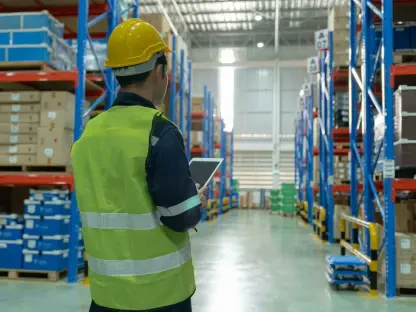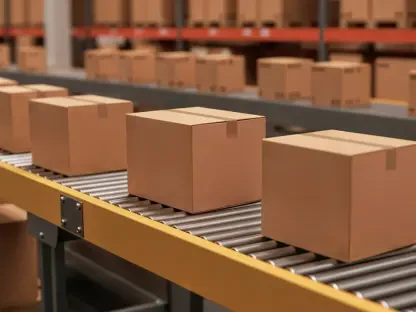Imagine a global supply chain where disruptions like trade tariffs or sudden policy shifts are not just detected but anticipated and countered in real time, saving millions in delays and inefficiencies. In 2025, this is no longer a distant dream but a tangible reality through connected intelligence—a transformative technology that integrates data, artificial intelligence (AI), and human expertise to redefine logistics. Amidst an era of unprecedented complexity, with supply chains stretched thin by geopolitical tensions and sustainability mandates, this framework emerges as a beacon of adaptability and resilience. This review delves into how connected intelligence is reshaping the logistics landscape, offering a detailed analysis of its features, performance, and transformative potential for an industry hungry for efficiency and transparency.
Core Features of Connected Intelligence
Seamless Real-Time Data Integration
At the heart of connected intelligence lies its ability to unify real-time data across diverse supply chain partners, creating a level of visibility that transcends traditional tracking metrics. Unlike older systems that merely report statuses, this technology transforms raw data into actionable insights, enabling stakeholders to monitor shipments, inventory, and disruptions with unparalleled precision. Such integration ensures that all parties—from carriers to shippers—operate on a single, synchronized view of operations, fostering trust and swift responsiveness.
This capability significantly enhances operational agility, particularly in volatile market conditions. By connecting disparate systems into a cohesive network, logistics teams can pivot instantly when faced with unexpected delays or bottlenecks. The result is a supply chain that not only reacts to challenges but often stays a step ahead, minimizing downtime and ensuring continuity even under pressure.
AI-Powered Insights and Automation
Another cornerstone of connected intelligence is its use of AI to drive predictive analytics and automate decision-making processes. Through sophisticated algorithms, the technology forecasts demand trends, identifies potential disruptions before they occur, and optimizes routing dynamically. This predictive power allows companies to plan with greater accuracy, reducing waste and enhancing resource allocation across vast networks.
Automation further amplifies these benefits by handling repetitive tasks such as scheduling or inventory updates, freeing human resources for strategic oversight. For logistics firms scaling operations, this means achieving growth without a corresponding surge in labor costs. The efficiency gains are evident in improved delivery times and reduced operational overhead, positioning AI as an indispensable ally in modern logistics.
Performance and Impact in Logistics Operations
Enhancing Operational Efficiency
The performance of connected intelligence shines brightest in its ability to streamline complex logistics operations. For instance, yard management—often a bottleneck in supply chains—becomes far more efficient as real-time data and AI optimize vehicle movements and reduce idle times. Similarly, carrier-shipper collaboration improves through shared platforms that enable dynamic updates to plans, ensuring alignment even amidst sudden changes.
Industries ranging from retail to manufacturing have reaped substantial benefits from these advancements. Companies leveraging this technology report not only faster turnaround times but also significant cost reductions, as automated systems minimize errors and redundancies. These gains underscore how connected intelligence turns operational challenges into competitive advantages.
Driving Resilience and Sustainability
Beyond efficiency, connected intelligence plays a pivotal role in building resilient supply chains capable of withstanding global disruptions. Early warning systems powered by AI detect risks such as port congestion or policy shifts, allowing proactive adjustments rather than costly reactions. This resilience is critical in an environment where supply chain interruptions can cascade rapidly across tiers of partners.
Equally important is its alignment with sustainability goals, especially under stringent regulations like the EU’s Corporate Sustainability Due Diligence Directive. By providing transparent data flows, the technology ensures compliance with environmental and ethical standards without sacrificing operational speed. This dual focus on resilience and responsibility marks a significant leap forward for logistics in balancing profit with planetary impact.
Challenges in Adoption and Implementation
Bridging the Digital Talent Gap
Despite its promise, adopting connected intelligence faces notable hurdles, chief among them being a persistent shortage of digital expertise. Surveys indicate that a staggering 90% of logistics leaders cite insufficient skills within their teams as a barrier to transformation. This gap hampers the ability to fully harness the technology, slowing the pace of innovation in an industry eager to modernize.
Efforts to address this challenge include scalable software solutions that simplify integration and reduce the need for specialized knowledge. Additionally, training programs and partnerships with tech providers are gaining traction as means to upskill existing workforces. However, closing this gap remains a critical priority for unlocking the full potential of connected intelligence.
Overcoming Strategic and Operational Barriers
Strategic impediments further complicate adoption, with many organizations lacking formal risk management processes at the board level to support tech-driven change. This disconnect between ambition and execution is compounded by slow progress in automation, as industry leaders anticipate limited advancements in the near term. Such inertia risks leaving firms unprepared for escalating supply chain complexities.
Collaborative initiatives, such as shared data ecosystems, offer a pathway to mitigate these issues by pooling resources and expertise among stakeholders. Standardizing data inputs and enhancing interoperability through modern platforms also help bypass operational silos. These steps, though gradual, are essential for aligning strategic vision with practical deployment.
Reflecting on the Journey of Connected Intelligence
Looking back, the journey of connected intelligence in reshaping logistics has proven to be a game-changer, delivering measurable gains in efficiency, resilience, and compliance despite initial adoption hurdles. Its integration of real-time data and AI-driven automation tackled longstanding inefficiencies, while collaborative ecosystems fostered trust and adaptability across supply chains. The technology’s ability to align operational goals with sustainability mandates stood out as a defining achievement, setting a new standard for responsible logistics.
Moving forward, the focus should shift to actionable strategies that accelerate adoption, such as investing in upskilling programs to address the digital talent shortage. Industry-wide collaboration on interoperable platforms can further dismantle data silos, ensuring broader access to transformative insights. As logistics continues to evolve, prioritizing these steps will be crucial for scaling connected intelligence, paving the way for even smarter, more sustainable supply chains in the years ahead.









